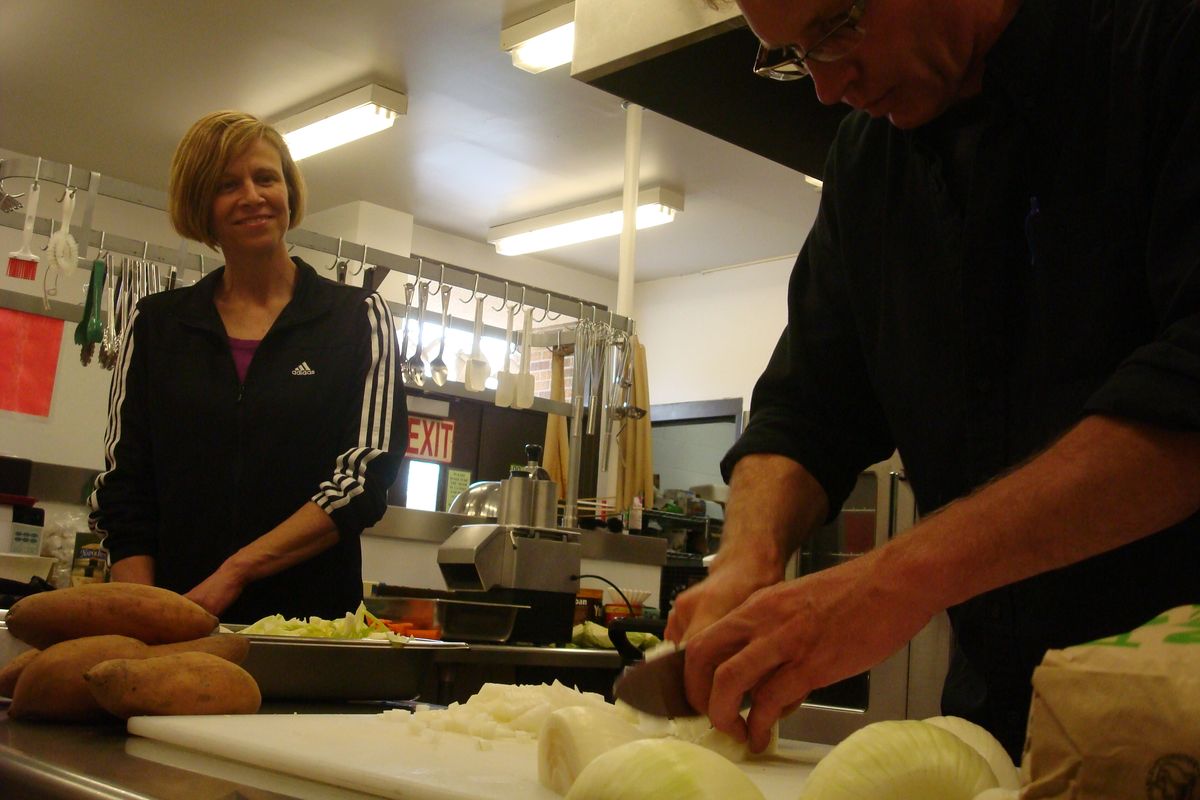Schools, farms connecting to benefit student meals
Part of process is encouraging kids to try new foods

Late last month, local farmers, school nutrition staff, and Department of Corrections representatives spent a day touring local farms, sampling locally-produced food, and learning how to wash, peel, chop, dice, and serve fresh produce in school kitchens.
Leading the tour were Becky Elias and Sue Davis from “Farm to Schools,” a Washington State Department of Agriculture program that works to increase the amount of Washington-grown foods purchased by state agencies, institutions, and schools.
Also helping facilitate the tour was Jennifer Hall, the Eastern Washington coordinator for “Fresh Food in Schools,” a program with similar goals which is run through the nonprofit Washington Sustainable Food & Farming Network.
The Farm-to-School tours are one way that Elias and Davis are attempting to connect local farmers with potential buyers and to hopefully facilitate long-term direct purchasing relationships. If successful, the result will be more fresh foods available at school lunchrooms.
The tour began at Rocky Ridge Ranch, where participants viewed leafy greens thriving within hoop houses and learned about the ranch’s hog and cattle operation.
Next, Fred Fleming of Shepherd’s Grain Producers shared his rural upbringing and demonstrated the effectiveness of no-till growing on soil retention and quality.
As the tour bus hauled participants towards the North Event Center Farm for lunch, relationships began to gel exactly how Elias and Davis had hoped - school cooks quizzed farmers about delivery options and price, and farmers inquired about storage capacity, demand and school calendars.
Eager to converse was Janette Root, food service director at Othello School District, who attended a previous farm tour and learned so much that she brought three of her cooks to this event.
From across the aisle, she and her cooks chatted with Dan Jackson, a full-time news photographer, father, husband and farmer of 2.2 acres, about his tomato varieties and delivery routes. Jackson promised, “When I say 10 pounds, it’s probably more – I never, ever short anybody.”
This networking continued through lunch, as participants dined on hearty Washington-grown fare designed to demonstrate a viable, all-local, school lunch.
Missing from the buffet were the syrup-soaked canned peaches, corn dogs, and neon-orange “cheese product” nachos that often present themselves as the only choices for hungry students. Instead, fed participants enjoyed baked potatoes with a broccoli-cheese topping, lentil and beef chili, green salad, fruit, and rolls, breadsticks and brownies made from Shepherd’s Grain flour.
While participants dined, Root shared her experiences with FoodHub, an online marketplace that she learned about on her first tour and that matches food buyers and sellers throughout the western United States.
Members post ‘wanted’ ads and producers post their products, ranging from a single case of peaches, to semi-truckload quantities. Searching is made easy through detailed sort and filter options that allow members to be specific about proximity, variety, and member type.
The Tuesday before the tour, Root shared that she had received 20 pounds of radishes from a local producer. “They were beautiful,” she told the group. “I was like, oh, we should leave the greens on them, the kids will think that is so cool. Well, they didn’t,” she laughed. “It’s going to take time.”
Root explained that the radishes went to the only school in their district with a functioning kitchen, which also happened to be the school that eats the least amount of vegetables. “There are 700 kids and honestly, they can maybe go through a bag of broccoli a day, maybe.”
Getting students to warm up to the idea of eating foreign vegetables is a hurdle that all participants acknowledged must be overcome. “I think once kids realize that their neighbor is the farmer that grew the potatoes, they will get more on board,” Root offered.
Another solution the group discussed was FoodSense, a WSU extension program that teaches students about nutrition. One participant claimed that this program’s hands-on “touch, taste, smell” approach was extremely effective in dispelling her kindergarteners’ fear of unknown produce. The 5 year-olds now regularly choose fresh fruits and vegetables over processed options.
Gearjean Kuntz of East Valley School District has also seen her kids receive farmers’ deliveries with enthusiasm and curiosity, rather than disdain. One day Kuntz decided to present fresh, local corn to her students.
“I let the kids shuck the ears themselves, and they loved it,” she told the group, “One kid actually asked me if I added sugar.”
East Valley now has its own school garden, which Kuntz believes has played a big role in broadening her students’ palates and in strengthening her community. “It is incredible to watch families working together and talking over a raised bed,” she said, “I tear up every time I talk about it.”
After lunch, the group travelled to Reardon School (K-12), where school representatives gathered in the kitchen for a cooking class and producers met in the cafeteria to pool knowledge and brainstorm solutions to logistical concerns.
While participants undoubtedly gained useful information from the formal presentations, it was the conversations that occurred on the bus, at the lunch table and between presentations that seemed to really lay the foundation for lasting partnerships.
Near the end of the day, Debbie Shaffer, who currently sells beef but is toying with expanding to vegetables, told her colleagues how inspired she was to hear their stories and explained why she chose to participate. “The health care industry needs us to do this. I believe that we are mal-nutritioned in this country, and we need to supply our children with the foundation they need to succeed.”
Sheryl Templeton of Grass Creek Farm agreed. “I believe I have a moral obligation to teach kids and families about food. I have two daughters who are teachers. I want to sell to schools, not for the income potential, but because I feel its my obligation. The potential for this program is enormous.”